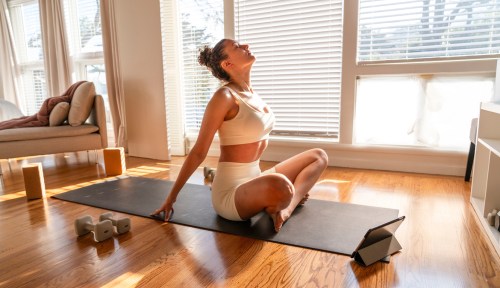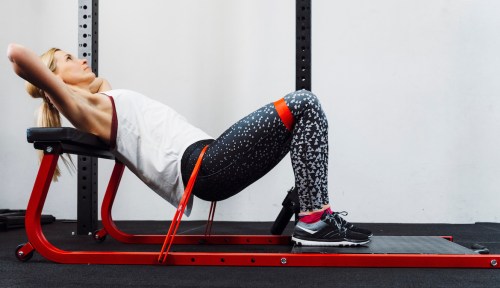Our editors independently select these products. Making a purchase through our links may earn Well+Good a commission
After two years of working at home, your neck and your upper back are killing you. You put your laptop on a couple of books on the kitchen table, do some yoga, and hope for the best, but you’re still tight and sore.
Why is this happening?
So many of the activities that are integral to modern life seem like they were designed to generate poor posture. Rounding forward over a steering wheel, desk, or phone stretches out the muscles in your neck and upper back while simultaneously tightening your chest. Your thoracic spine—the part that runs from the bottom of your ribcage to just below your neck—naturally curves forward, and that forward curve can turn into a hump over time when you spend hours every day in a hunched position.
I’m a Pilates instructor, and while everyone’s body is different, from what I’ve seen with my clients over the years, I know that the key to “un-desking” your neck and back is to strengthen what’s too loose and to stretch what’s too tight. Here are three of my favorite exercises that can help relieve that upper back pain.
1. Foam roller arm circles
This is a great exercise for stretching tight chest muscles and mobilizing stiff shoulders. I like to do this at the beginning of a workout, but it’s also a great cool-down.
- 1.Lie on a foam roller with your entire spine (from the top of your head all the way down to your tailbone) supported, and plant your feet sitz bone–distance apart.
- 2.Draw your navel into your spine and reach your arms up to the ceiling. Soften your ribcage into the foam roller, and reach your arms as far behind you as you can without your rib cage flaring.
- 3.Circle your arms down to your hips, and back up to the ceiling.
- 4.Repeat three to five times in each direction.
Variation: Hold one- to three-pound weights to increase the stretch.
2. Baby cobra
The goal of this exercise is not to make a shape that looks a certain way, but to strengthen your upper back and give your thoracic spine some much needed extension. Pay attention to how this feels—don’t worry about how high off the mat you can go.
- 1.Lie on your stomach and layer your hands one over the other underneath your forehead. Let your head rest on your hands and imagine that the back of your neck is getting longer—if you like metaphors, imagine that you’re a kitten getting picked up by the scruff of its neck.
- 2.Pick your hands, head, and chest up off the mat and hold briefly, pull your shoulders down away from your ears, and then lower back down to the mat.
- 3.Repeat five times.
Variations: If you’re feeling a lot of tension in your neck during this exercise, try keeping your hands and forearms on the mat and slightly lifting your head and shoulders up. If you have a small exercise ball, you can try placing it under your sternum to get a better range of motion.
3. Chest expansion
This Pilates exercise stretches your chest and strengthens the muscles in your upper back and shoulders. You can do it with Pilates equipment, small weights, a resistance band, or no equipment at all, but I think a light resistance band is a good place to start.
- 1.Start by kneeling on a mat.
- 2.Hold the band with your hands about six inches apart at shoulder height. Slightly pull on the resistance band so that your hands are just further apart than your shoulders and you can feel some activation of the muscles in between your shoulders.
- 3.Hold the tension in the band as you bring your arms down to your hips and imagine that your collar bones are getting wider.
- 4.Holding your hands down by your hips and keeping your chest open, look over your right shoulder, look over your left shoulder, and then bring your arms back up to shoulder height.
- 5.Repeat six to eight times.
Variation: If you have sensitive knees, you can do this standing up.
Sign Up for Our Daily Newsletter
Get all the latest in wellness, trends, food, fitness, beauty, and more delivered right to your inbox.
Got it, you've been added to our email list.











